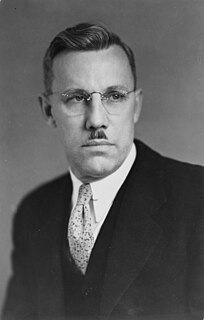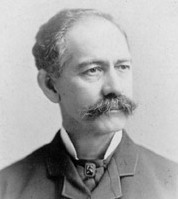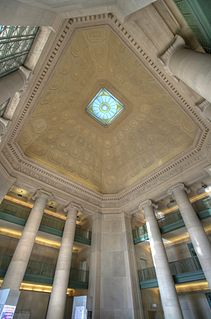
Massachusetts Institute of Technology (MIT) is a private research university in Cambridge, Massachusetts. The institute is a land-grant, sea-grant, and space-grant university, with an urban campus that extends more than a mile (1.6 km) alongside the Charles River. The institute also encompasses a number of major off-campus facilities such as the MIT Lincoln Laboratory, the Bates Center, and the Haystack Observatory, as well as affiliated laboratories such as the Broad and Whitehead Institutes. Founded in 1861 in response to the increasing industrialization of the United States, MIT adopted a European polytechnic university model and stressed laboratory instruction in applied science and engineering. It has since played a key role in the development of many aspects of modern science, engineering, mathematics, and technology, and is widely known for its innovation and academic strength.
The term public art refers to a specific art genre with its own professional and critical discourse. It represents art in any media whose form, function and meaning are created for the general public through a public process. Public art is visually and physically accessible to the public – it is installed or staged in public space or the public realm, usually outside. Public art embodies public or universal concepts rather than commercial, partisan or personal concepts or interests, and it has clear aesthetic qualities in form or theme. Notably, public art is also the direct or indirect product of a public process of creation, procurement, and/or maintenance.

Richardsonian Romanesque is a style of Romanesque Revival architecture named after architect Henry Hobson Richardson (1838–1886). The revival style incorporates 11th and 12th century southern French, Spanish and Italian Romanesque characteristics. Richardson first used elements of the style in his Richardson Olmsted Complex in Buffalo, New York, designed in 1870. Multiple architects followed in this style in the late 1800s; Richardsonian Romanesque later influenced modern styles of architecture as well.
Interaction design, often abbreviated as IxD, is "the practice of designing interactive digital products, environments, systems, and services." Beyond the digital aspect, interaction design is also useful when creating physical (non-digital) products, exploring how a user might interact with it. Common topics of interaction design include design, human–computer interaction, and software development. While interaction design has an interest in form, its main area of focus rests on behavior. Rather than analyzing how things are, interaction design synthesizes and imagines things as they could be. This element of interaction design is what characterizes IxD as a design field as opposed to a science or engineering field.

Katie Salen Tekinbas is a game designer, animator, and educator. She is a professor at the University of California, Irvine. Previously, she taught at DePaul University College of Computing and Digital Media, Parsons The New School for Design the University of Texas at Austin, New York University, and the Rhode Island School of Design. She has an MFA in graphic design from the Rhode Island School of Design.

Kevin Andrew Lynch was an American urban planner and author. He is known for his work on the perceptual form of urban environments and was an early proponent of mental mapping. His most influential books include The Image of the City (1960), a seminal work on the perceptual form of urban environments, and What Time is This Place? (1972), which theorizes how the physical environment captures and refigures temporal processes.

Conde Balcom McCullough was an American civil engineer who is primarily known for designing many of Oregon's coastal bridges on U.S. Route 101. The native of South Dakota worked for the Oregon Department of Transportation from 1919 to 1935 and 1937 until 1946. McCullough also was a professor at Oregon State University.

The Patrick V. McNamara Federal Building is a class-A skyscraper located at 477 Michigan Avenue in Downtown Detroit, Michigan, designed by the Detroit architectural firm of Smith, Hinchman and Grylls. It opened in 1976 to consolidate the offices of federal agencies which were scattered in several locations in the area. It houses offices of the Consumer Product Safety Commission, Army Corps of Engineers, Defense Contract Management Agency, Federal Bureau of Investigation, United States Department of Housing and Urban Development(HUD), Internal Revenue Service, Peace Corps, Railroad Retirement Board, Veteran Affairs (VA), The American Legion Department of Michigan and Social Security Administration. It is named for Patrick V. McNamara, a Democratic United States Senator from the State of Michigan from 1955 to 1966.

The Heian Palace was the original imperial palace of Heian-kyō, the capital of Japan, from 794 to 1227. The palace, which served as the imperial residence and the administrative centre of for most of the Heian period, was located at the north-central location of the city in accordance with the Chinese models used for the design of the capital.

John Griffith McCullough was an American businessperson and attorney. He was Attorney General of California during the Civil War, and the 49th Governor of Vermont from 1902 to 1904.

The MIT School of Architecture and Planning is one of the five schools of the Massachusetts Institute of Technology, located in Cambridge, Massachusetts. Founded in 1865 by William Robert Ware, the School offered the first formal architectural curriculum in the United States, and the first architecture program in the world operating within the establishment of a University. MIT SAP is considered a global academic leader in the design fields and one of the most prestigious schools in the world. MIT's Department of Architecture has consistently ranked among the top architecture/built environment schools in the world, and from 2015-2018 was ranked highest in the world in QS World University Rankings. In 2019, it was ranked second to The Bartlett but regained the number one position in the 2020 rankings.
Mónica Ponce de León is an architect, educator, and Dean of the Princeton University School of Architecture. A National Design Award winner, Ponce de León is widely recognized as a pioneer in the application of robotic technology to building fabrication and architecture education. Her interdisciplinary practice, MPdL Studio, has offices in New York, NY, Boston, MA, Princeton, NJ and Ann Arbor, MI. Ponce de León previously served as Dean of the A. Alfred Taubman College of Architecture and Urban Planning at the University of Michigan (2008–2015) and as Professor at the Graduate School of Design at Harvard University (1996–2008). Prior to establishing her own practice MPdL Studio in 2011, she was the founding partner with Nader Tehrani in the award-winning firm Office dA.
Richard Louis Meier was a US regional planner, systems theorist, scientist, urban scholar, and futurist, who was Professor in the College of Environmental Design at the University of California at Berkeley. He was an early thinker on sustainability in planning, and recognized as a leading figure in city planning and development. He is not related to the New York-based architect Richard Meier, with whom he was often confused.
Arthur Guy Zajonc is a physicist and the author of several books related to science, mind, and spirit; one of these is based on dialogues about quantum mechanics with the Dalai Lama. Zajonc, professor emeritus at Amherst College as of 2012, has been teaching there since 1978. He has served as the General Secretary of the Anthroposophical Society in America. From January 2012 to June 2015 he was president of the Mind and Life Institute.
The MIT Senseable City Laboratory aims to investigate and anticipate how digital technologies are changing the way people live and their implications at the urban scale. Director Carlo Ratti founded the Senseable City Lab in 2004 within the City Design and Development group at the Department of Urban Studies and Planning, as well as in collaboration with the MIT Media Lab. The Lab's mission states that it seeks to creatively intervene and investigate the interface between people, technologies and the city. Recent projects include "The Copenhagen Wheel" which debuted at the 2009 United Nations Climate Change Conference, "Trash_Track" shown at the Architectural League of New York and the Seattle Public Library, "New York Talk Exchange" featured in the MoMA The Museum of Modern Art, and Real Time RomeReal Time Rome included in the 2006 Venice Biennale of Architecture.

Benjamin H. Bratton is an American sociologist, architectural and design theorist, known for a mix of philosophical and aesthetic research, organizational planning and strategy, and for his writing on the cultural implications of computing and globalization.

Urban planning is a technical and political process concerned with the development and design of land use and the built environment, including air, water, and the infrastructure passing into and out of urban areas, such as transportation, communications, and distribution networks. Urban planning deals with physical layout of human settlements. The primary concern is the public welfare, which includes considerations of efficiency, sanitation, protection and use of the environment, as well as effects on social and economic activities. Urban planning is considered an interdisciplinary field that includes social science, architecture, human geography, politics, engineering and design sciences. It is closely related to the field of urban design and some urban planners provide designs for streets, parks, buildings and other urban areas. Urban planning is also referred to as urban and regional planning, regional planning, town planning, city planning, rural planning, urban development, physical planning, urban management or some combination in various areas worldwide.
Urban informatics refers to the study of people creating, applying and using information and communication technology and data in the context of cities and urban environments. Various definitions are available, some provided in the Definitions section. Urban informatics is a trans-disciplinary field of research and practice that draws on three broad domains: people, place and technology.
Barbara McCullough is a director, production manager and visual effects artist whose directorial works are associated with the Los Angeles School of Black independent filmmaking. She is best known for Water Ritual #1: An Urban Rite of Purification (1979), Shopping Bag Spirits and Freeway Fetishes: Reflections on Ritual Space (1980), Fragments (1980), and World Saxophone Quartet (1980).
Brian House is an American contemporary new media artist. His work deals primarily with the intersection of digital technology and the material world. It frequently incorporates sound and site-specific performance.










